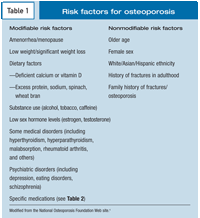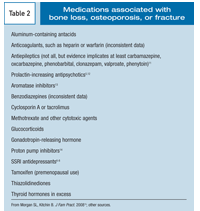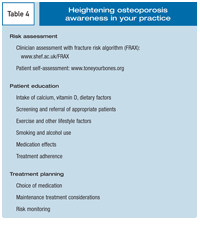Bone Mass Density Loss and Antidepressants: Another Tough Break for SSRI Users?
When I was recently asked by a patient about the link between osteoporosis and SSRIs, I dimly recalled this topic’s emergence in a medical journal in 2007, its subsequent meander through several newsletters, and its gradual return to the bottom of my mental risk-assessment checklist.

When I was recently asked by a patient about the link between osteoporosis and SSRIs, I dimly recalled this topic’s emergence in a medical journal in 2007, its subsequent meander through several newsletters, and its gradual return to the bottom of my mental risk-assessment checklist.
I asked several colleagues whether they had added bone mass density (BMD) loss to the pantheon of practice-altering medication risks we have learned to consider when prescribing antidepressants, or even to the list of disturbing and more or less common experiences (eg, sexual dysfunction, sweating, nightmares, myoclonus, apathy, discontinuation syndrome, hyponatremia, bradycardia/hypotension) that taint SSRI benefits for some patients. My informal inquiry and review of the literature suggested that a column on this topic would be timely.
Osteoporosis-the development of bone porosity-results from the deterioration of bone tissue that predisposes to low-trauma fractures, especially of the hip, spine, or wrists. Early BMD loss and osteoporosis are asymptomatic and often develop over a number of years, reflecting the convergence of multiple disruptive influences on the process of bone remodeling.1 Without directed attempts to diagnose osteoporosis in asymptomatic persons at risk for BMD loss, clinical recognition may be delayed until the occurrence of backache, height loss, or a fracture associated with minimal physical trauma (such as a fall from standing height).2 Such “fragility fractures” added an estimated 5.8 million disability-adjusted life-years to the global health burden in 2000.2
Background on risk

Osteoporosis is present in 15% of whites in their 50s and in 70% of those older than 80 years.3 Although 80% of persons with osteoporosis are women, men affected by hypogonadism or a host of other disorders are vulnerable as well. Osteoporosis occurs at the highest rates among non-Hispanic white and Asian women aged 50 or older, but no ethnic group is unaffected.4
In certain at-risk subpopulations, bone loss is accelerated. Various sources, including the informative Web site of the National Osteoporosis Foundation (www.nof.org) provide lists of modifiable and nonmodifiable risk factors (Table 1). Among the prescribed medications that compound modifiable risk (Table 2), the glucocorticoids and antiepileptic drugs are most widely known. However, 2 additional medication classes that figure prominently in psychiatric practice have also been reported to increase the risk of osteoporosis: the prolactin-increasing antipsychotics5 and the SSRIs.6-9 The SSRIs, about which recent data are available, will be the focus here.
SSRI effects on BMD

A need for examination of the effects of SSRIs on bone integrity was suggested as early as 1998 in a case-control study that linked use of SSRIs or tricyclic antidepressants (TCAs) with increased risk for hip fractures in elderly persons.9 Concern flared again last year with the publication of several important studies. Haney and colleagues6 reported the results of a cross-sectional analysis of data from a prospective observational study of 5995 men, 65 years and older, of whom 160 were SSRI users. Compared with men who were taking no antidepressant, the SSRI users (but not users of trazodone or TCAs) had significantly lower BMD in the hip and lumbar spine. The magnitude of the association appeared to be similar to that linked with glucocorticoid use in this cohort, although the meaning of this finding was unclear because detailed data about the amount and route of glucocorticoid use were too limited. After considering the roles of several potential confounding factors, these authors concluded that the association between low BMD and SSRI use was not explained by the presence of depressed mood, as measured by the score from the 12-item Short Form of the Medical Outcomes Study, Mental Component Scale.
A prospective study compared serial measurements of BMD in a cohort of 2722 women 65 years and older who were taking an SSRI or a TCA.7 The mean interval between the BMD measurement visits was 4.9 years. Depression was measured with the Geriatric Depression Scale (GDS), and the use of concurrent medications and calcium supplements was recorded. The SSRI users, but again not TCA users, showed a higher rate of bone loss in total hip measurements compared with nonusers. Because the SSRI-user cohort included more patients with a GDS score of at least 6 than the TCA-user cohort, the results were re-analyzed; patients whose GDS score was at least 6 during one of the BMD visits were excluded. This exclusion decreased the magnitude but did not eliminate the significance of the greater decrease in BMD observed in SSRI users.
A study by Richards and colleagues8 focused more directly on fracture risk than BMD loss. These investigators compared the incidence of fractures among SSRI users and nonusers in a prospective cohort of 5008 community-dwelling adults aged 50 or older over a 5-year interval in the Canadian Multicentre Osteoporosis Study. Most of these patients also had lumbar spine and hip BMD measurements. Estrogen and SSRIs were the most frequently used medications by these patients. Daily SSRI use was associated with a 2-fold increase in fracture risk and significantly lower total hip BMD measures. The effect of depressive symptoms, as assessed with scales of the Medical Outcomes Study ShortForm–36, was controlled for in this study.

Hypothetical mechanisms for the effects of SSRI on BMD include a reduction in osteoblast activity resulting from serotonin transporter inhibition or a reduction in remodeling resulting from SSRI interference with osteoclast differentiation.6 This direct serotonergic effect differs from any of the several proposed mechanisms used to explain the well-documented BMD loss associated with depression (Table 3). It is conceivable and consistent with the findings of Diem and colleagues7 that BMD loss associated with depression and SSRI use might even be additive in some patients, although successful treatment of depression might decrease the depression-related component of BMD loss. No study has compared the magnitude of the effects of SSRIs and depression on bones, and I could locate no study that addresses serotonin norepinephrine reuptake inhibitor (SNRI) effects on BMD, although the SNRIs’ serotonergic effects certainly raise the possibility of a similar BMD reduction risk.
Effects of findings on treatment

How should this information about osteoporosis affect the practice of a prudent (and alliterative) psychiatrist? As summarized in Table 4, risk assessment is relatively quick and simple thanks to readily available assessment resources. These include the World Health Organization’s fracture risk algorithm (FRAX, an interactive Web-based, printable assessment tool available at www.shef.ac.uk/FRAX) or the very patient-friendly Web site “Tone Your Bones,” offered through the Osteoporosis Prevention and Treatment Clinic at the University of Alabama at Birmingham (www.toneyourbones.org). The latter Web site also offers advice about intake of calcium and other nutrients, attention to dietary factors that affect bone, a list of medications implicated in BMD loss, suggestions regarding bone-strengthening physical exercises, and lucid discussion of the available medications that prevent or palliate osteoporotic bone changes (including the pros and cons of hormone replacement therapy and the use of oral bisphosphonates and the parathyroid hormonelike, teriparatide).
We can promote osteoporosis awareness among our patients and direct them toward screening or further assessment in primary care, particularly among at-risk persons and women aged 65 or older who have not already been screened.10 Osteoporosis medications can be included among those we discuss in assessing treatment adherence. Although the deleterious effects of depression, malnutrition-inducing anorexia, or psychosis may outweigh bone-related risks of SSRIs or prolactin-increasing antipsychotic medications, you may wish to discuss bone health with your patients (particularly those at high risk) before prescribing these medications. During the maintenance phase of treatment, you may choose to include bone effects among the other risk and benefit factors that influence the decision to continue, adjust dosing, or eliminate medications in asymptomatic patients. For some vulnerable persons, initial treatment or a switch to maintenance with a nonserotonergic antidepressant may be a consideration.
It has not been and most likely will not become the psychiatrist’s role to treat bone disease, but these new data should increase the prominence of osteoporosis in our awareness. Loss of BMD occurs not only as a concomitant of aging but also as a con-sequence of medical or psychiatric disorders-and of the medications patients take and the ones we prescribe. As the clinical complexity of our patients and of our treatments continues to increase, psychiatrists can play a valuable role in patient care by heightening awareness of osteoporosis; increasing the recognition of at-risk individuals; and helping to prevent progression of this common, harmful, and potentially life-shortening condition.
References:
References
1. Duque G, Troen BR. Understanding the mechanisms of senile osteoporosis: new facts for a major geriatric syndrome. J Am Geriatr Soc. 2008;56:935-941.
2. Poole KE, Compston JE. Osteoporosis and its management. BMJ. 2006;333:1251-1256.
3. Dawson-Hughes B; National Osteoporosis Foundation Guide Committee. A revised clinician’s guide to the prevention and treatment of osteoporosis. J Clin Endocrinol Metab. 2008;93:2463-2465.
4. National Osteoporosis Foundation.
http://www.nof.org
. Accessed on July 1, 2008.
5. O’Keane V, Meaney AM. Antipsychotic drugs: a new risk factor for osteoporosis in young women with schizophrenia? J Clin Psychopharmacol. 2005;25:
26-31.
6. Haney EM, Chan BK, Diem SJ, et al; Osteoporotic Fractures in Men Study Group. Association of low bone mineral density with selective serotonin reuptake inhibitor use by older men. Arch Intern Med. 2007;167:1246-1251.
7. Diem SJ, Blackwell TL, Stone KL, et al. Use of antidepressants and rates of hip bone loss in older women: the study of osteoporotic fractures. Arch Intern Med. 2007;167:1240-1245.
8. Richards JB, Papaioannou A, Adachi JD, et al; Canadian Multicentre Osteoporosis Study Research Group. Effect of selective serotonin reuptake inhibitors on the risk of fracture. Arch Intern Med. 2007;167:188-194.
9. Liu B, Anderson G, Mittmann N, et al. Use of selective serotonin-reuptake inhibitors or tricyclic antidepressants and risk of hip fractures in elderly people. Lancet. 1998;351:1303-1307.
10. US Preventive Services Task Force. Screening for osteoporosis in postmenopausal women: recommendations and rationale. Ann Intern Med. 2002;137:526-528.
11. Valsamis HA, Arora SK, Labban B, McFarlane SI. Antiepileptic drugs and bone metabolism. Nutr Metab (Lond). 2006;3:36-43.
12. Liu-Seifert H, Kinon BJ, Ahl J, Lamberson S. Osteopenia associated with increased prolactin and aging in psychiatric patients treated with prolactin-
elevating antipsychotics. Ann N Y Acad Sci. 2004; 1032:297-298.
13. Lester J, Coleman R. Bone loss and the aromatase inhibitors. Br J Cancer. 2005;93(suppl 1):S16-S22.
14. Yang YX, Lewis JD, Epstein S, Metz DC. Long-term proton pump inhibitor therapy and risk of hip fracture. JAMA. 2006;296:2947-2953.
15. Morgan SL, Kitchin B. Osteoporosis: handy tools for detection, helpful tips for treatment. J Fam Pract. 2008;57:311-320.
16. Cizza G, Ravn P, Chrousos GP, Gold PW. Depression: a major, unrecognized risk factor for osteoporosis? Trends Endocrinol Metab. 2001;12:198-203.
